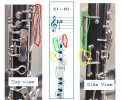Hi,
I have been wanting to buy an english horn and found someone selling a used Boosey & Hawkes.
B&H don't seem to be selling english horns any longer, so I am wondering if I should go ahead.
Any opinions on the quality and playability of these would be appreciated.
Also a price range as to what it may be worth...
I am new to playing double reeds. I have a oboe but have a difficult time playing on pitch.
It is really the english horn I would love to play and am thinking the lower pitch of the instrument may make it easier to play in tune. Is this the same as the difference between a soprano sax which I have hard time playing in tune vs an alto?
Dan
I have been wanting to buy an english horn and found someone selling a used Boosey & Hawkes.
B&H don't seem to be selling english horns any longer, so I am wondering if I should go ahead.
Any opinions on the quality and playability of these would be appreciated.
Also a price range as to what it may be worth...
I am new to playing double reeds. I have a oboe but have a difficult time playing on pitch.
It is really the english horn I would love to play and am thinking the lower pitch of the instrument may make it easier to play in tune. Is this the same as the difference between a soprano sax which I have hard time playing in tune vs an alto?
Dan

